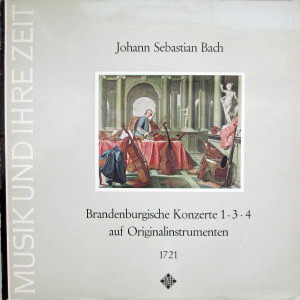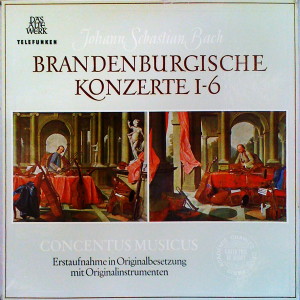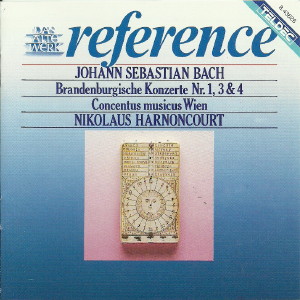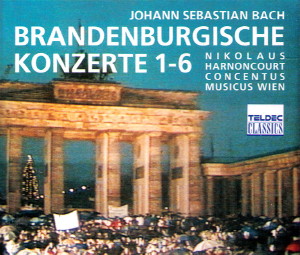 |
1 LP -
SAWT 9459-A - (p) 1964
|
 |
| 2 LP -
SAWT 4959/60-A - (c) 1964 |
 |
| 1 CD -
8.43626 ZS - (c) 1987 |

|
| 2 CD -
9031-71089-2 - (c) 1990 |
|
Johann
Sebastian Bach (1685-1750) -
Brandenburgische Konzerte 1 - 3 - 4 auf
Originalinstrumenten
|
|
|
|
|
|
|
|
| Concerto III G-dur, BWV 1048 |
|
11' 44" |
|
| - (Allegro) |
6' 19" |
|
A1 |
| - (Adagio) |
0' 28" |
|
A2 |
- Allegro
|
4' 57" |
|
A3 |
|
|
|
|
| Concerto I F-dur, BWV 1046 |
|
22' 41" |
|
- (Allegro)
|
4' 21" |
|
A4 |
- Adagio
|
4' 31" |
|
A5 |
- Allegro
|
4' 38" |
|
A6 |
| - Menuet - Trio - Menuet -
Polonaise - Menuet - Trio - Menuet |
9' 11" |
|
B1 |
|
|
|
|
| Concerto IV G-dur, BWV 1049 |
|
16' 38" |
|
| - Allegro |
7' 29" |
|
B2 |
| - Andante |
4' 08" |
|
B3 |
| - Presto |
5' 01" |
|
B4 |
|
|
|
|
| Concentus
musicus, Wien / Nikolaus
Harnoncourt, Leitung |
III
|
I
|
IV |
|
|
| -
Alice Harnoncourt, Violine,
Violine piccolo*, Solovioline** |
o
|
o* |
o** |
|
|
| -
Stefan Plott, Violine |
o
|
o |
o |
|
|
| -
Siegfried Führlinger, Violine |
o |
o |
o |
|
|
| -
Kurt Letofsky, Bratsche (Viola) |
o |
|
|
|
|
| -
Kurt Theiner, Bratsche (Viola) |
o |
o |
o |
|
|
-
Josef de Sordi, Bratsche
(Viola)*, Violine*
|
o* |
o |
o |
|
|
| -
Kurt Letofsky, Bratsche (Viola) |
o |
|
|
|
|
| -
Hermann Höbarth, Violoncello |
o |
|
|
|
|
| -
Ernst Knava, Violoncello |
o |
|
|
|
|
| -
Nikolaus Harnoncourt, Violoncello |
o
|
o |
o |
|
|
-
Eduard Hruza, Kontrabaß (Violone)
|
o
|
o |
o |
|
|
| -
Hermann Rohrer, Horn (Corno da
caccia) |
|
o |
|
|
|
| -
Hans Fischer, Horn (Corno da
caccia) |
|
o |
|
|
|
| -
Leopold Stastny, Flauto dolce |
|
|
o |
|
|
| -
Jürg Schaeftlein, Oboe, Flauto
dolce* |
|
o |
o* |
|
|
| -
Karl Gruber, Oboe |
|
o |
|
|
|
| -
Bernhard Klebel, Oboe |
|
o |
|
|
|
| -
Otto Fleischmann, Fagott |
|
o |
|
|
|
| -
Georg Fischer, Cembalo |
o
|
o |
o |
|
|
|
Luogo e data
di registrazione
|
| Schönburg-Palais, Vienna
(Austria) - 31 marzo / 11 aprile 1964 |
|
Registrazione
live / studio
|
| studio |
Producer / Engineer
|
Wolf Erichson / Dieter Thomsen
|
Prima Edizione
CD
|
- Teldec "reference" - 8.43626
ZS - (1 cd) - 51' 24" - (c) 1987 - AAD -
Concerti III - I - IV
- Teldec - 9031-77089-22 - (2 cd) - 48'
36" + 56' 43" - (c) 1990 - ADD -
Concerti I-VI
|
Prima
Edizione LP
|
- Telefunken "Das Alte Werk" -
SAWT 9459-A - (1 lp) - 51' 24" - (p)
1964 - Concerti III - I - IV
- Telefunken "Das Alte Werk" - SAWT
9459/9460-B - (2 lp) - 51' 24" + 53' 44"
- (c) 1964 - Concerti I-VI
|
|
|
Notes
|
The
Brandenburg Concertos were
originally written, as
modern research has
established, for the Köthen
Court Orchestra, of which
Bach was conductor. The
instrumentation of the
concertos corresponds
exactly with the composition
of the orchestra. The expert
musicians necessary for the
extremely difficult solo
parts were employed here as
"Cammer Musici": the
violinist Josef Spiess, the
oboist Friedrich Rose, the
flautists Heinrich Freitag
und Johann Gottlieb Würdig,
the trumpeter Johann Ludwig
Schreiber. Horn players, who
were needed for the first of
the concertos, were not
permanently employed; there
were, however, often
travelling horn virtuosos
(always in pairs) at Köthen,
where they wished to be
heard. The gamba was played
by Christian Ferdinand Abel
and the Prince himself the
’cello by Christian Bemard
Linigke. In addition, a
further violinist and a
bassoon player were also
employed as "Cammer Musici",
and there were also four
other ordinary "Musici". We
can thus form an accurate
mental picture of the
orchestral forces Bach had
"in his ear" when he wrote
the Brandenburg Concertos,
and how they were originally
played.
Much has been written about
the formal relationship of
these concertos to the type
of the Italian Concerto
grosso. As in nearly all
other cases too, Bach has,
in these concertos, made
great changes to the
traditional form in order to
adapt it to suit his ideas.
The contrast between tutti
and solo is, of course, here
too the decisive element in
the form of the works; what
is new is the freedom and
variety with which these
media are applied, and in
addition to conventional
solo passages accompanied by
the strings or the continuo,
there are others in which
all instruments are involved
with equal importance.
Consequently these stand out
from the more massive tutti
blocks only by virtue of
their part writing and tone
quality. The
instrumentation, too, goes
further than anything know
up till then: in the First
Concerto we find two
concerto horn parts for the
first time in musical
history, the Second is the
only work that has come down
to us in which a high F
trumpet is used. The Fifth
is the first concerto known
to us for a keyboard
instrument. There are no
previous models for the
selection of instruments
found in the Third, Fourth
and Fifth Concertos; their
original instrumentation,
which goes to the very
limits of the possible,
indicates the importance of
the various components of
tone character in the
performance of these works.
The Third Concerto,
consisting only of two quick
movements, is a splendid
demonstration of pure string
tone. Three violins, three
violas and three cellos are
contrasted with each other
as groups. Solo and tutti
passages are skilfully
interwoven with one
anotherin the first
movement, each player coming
forward as a soloist from
the group several times. Two
chords lead into the second
movement; in accordance with
the old custom they have to
be embellished by a little
cadenza. In this purely
string concerto it should
naturally be played by a
string instrument rather
than by the harpsichord,
which here has only an
accompanying function. In
the second Allegro it is
only the first violin and
the first viola that are
honoured as soloists, but it
forms a finale which is a
unique demonstration of
collective virtuosity.
The most remarkable work as
regards form is the First
Concerto. A normal concerto
in three movements is
followed by an almost
independent sequence of
dances grouped around a
minuet. The instrumentation
is markedly treated as three
choirs of instruments:
strings, oboes with bassoon
and a pair of horns. The
latter have not been built
homogeneously into the
ensemble; the horn players,
after all, were not members
of the court orchestra, and
their performances
inevitably awakened hunting
associations. Bach
emphasizes this musical
character by introducing the
horns in a hunting call in
triplet rhythm, which they
add as if "from outside" to
the first tutti ofthe
ensemble proper. The violin
solos in the second and
third movements must be
played on a piccolo violin,
tuned a third higher than
the normal instrument. Bach
demands this instrument
purely for the sake of its
tone colour; there are no
technical reasons why it
should have been chosen. The
very delicate and yet
incisive tone of this violin
contrasts wonderfully with
that of the oboes as also
with that of the other
string instruments. In the
velvet-smooth tone of the
string Polonaise, it is
silent.
The Fourth Concerto is, in
the first place, a violin
concerto. On account of the
echo effects in the second
movement, Bach calls the two
solo recorders "Flauti
d’Echo". ln this movement
the quaver notes are played
rhythmically unevenly, in
accordance with former
practice in performance
(Quantz wrote in 1752:
"...the notes must... be
played slightly unevenly...
so that the first, third and
fifth are held somewhat
longer than the passing
notes... though not as long
as if dots stood beside
them...").
Nikolaus
Harnoncourt
|
|
Nikolaus
Harnoncourt (1929-2016)
|

|

|
|